
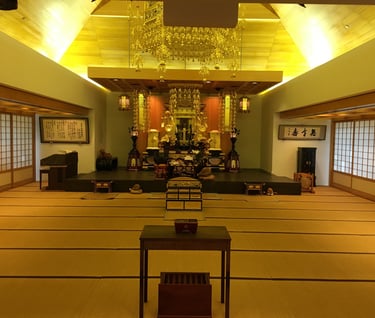
The Main Hall (Hondō)
本堂
Entering the main hall (hondō 本堂) we find the altar, surrounded by a typical arrangement of the various adornments (shōgon 荘厳) and equipment used in the temple services.

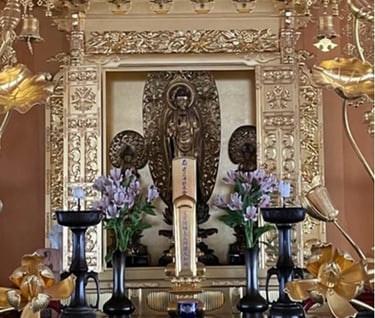
Buddha Amida
阿弥陀如来
The main figure (gohonzon 御本尊) is the Buddha Amida, who has two different Sanskrit names: Amitāyus (“Immeasurable Life”) and Amitābha (“Immeasurable Light”). While the Buddha Shākyamuni lived in our world at a specific time, the Buddha Amida did not.
In Mahayana Buddhism there are many such trans-historical Buddhas who represent a type of spiritual awareness that transcends time and space and yet is capable of working within that framework as well. The active aspect of this spirituality is often represented by the figure of the bodhisattva, or “enlightenment being.” A bodhisattva delays his or her own enlightenment for the sake of others and is determined to stay within the cycle of birth and death until everyone is liberated.
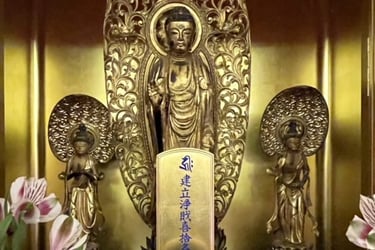

Bodhisattva Kannon and Bodhisattva Seishi
観音菩薩・勢至菩薩
To the left and right of Amida are two bodhisattva figures. To the left (our right as we face the Buddha) is the Bodhisattva Kannon (Skt. Avalokiteshvara).
Kannon represents compassion, or compassionate activity in the world. To the other side is the Bodhisattva Seishi (Skt. Mahāsthamaprapta), who represents wisdom. When compassion and wisdom are balanced in a religion, or in one’s life, there is a harmonious functioning of the whole. When they are not balanced, the result is often either fanaticism (too much on the warm side), or dry and sterile intellectualism (too much on the cool side).
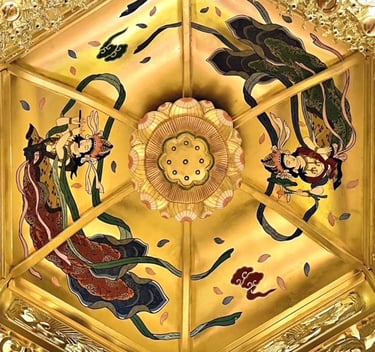

Buttengai and Nintengai (Golden Canopies)
仏天蓋・人天蓋
Above the Buddha’s head is a golden canopy, which is called the “heavenly canopy for the Buddha” (buttengai 仏天蓋), while in the center of the room is a larger canopy called the “heavenly canopy for the people” (nintengai人天蓋). Two golden banners hang before the altar and two vases hold large golden lotus flowers.
These are all standard ornaments found in Japanese Buddhist temples but they are more than mere decoration. All of these elements represent the attainment of enlightenment and the belief that it has been attained and is being manifested at this very moment.
For the Pure Land sects this is a key point. Here we are now in this human body, and there is the Buddha of Infinite Life and Infinite Light in his glorious Buddha body, with his pure world of enlightenment (his “pure land”) established, and the two apparent opposites form one complete unity. This understanding finds expression in the phrase “Dharma and individual, in essence one” (kihō ittai 機法一体), in which “individual” means the person who puts his trust in the Buddha of Infinite Life, and “Dharma” means the Buddha in the form of the fruition of the bodhisattva vows and practices, now manifesting as the light of wisdom and compassionate embracing the individual and bringing him into the Pure Land.
In the same way the “namu” of namu-amidabutsu can be seen as the individual surrendering himself to the Buddha, while the “amidabutsu” of the phrase is the Buddha of Infinite Life. The two come together in the form of nembutsu: “namu-amidabutsu.”

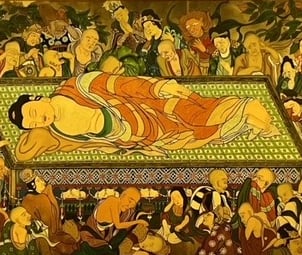
Nehanzu (the Great and Final Nirvana)
涅槃図
Turning and facing the entrance of the main hall we see a large painting depicting the death of the Buddha Shākyamuni, his so-called mahā-parinirvana, or passing into the final nirvana. The literal meaning of the word nirvana is “to blow out” or “to extinguish.”
In Buddhism it means to annihilate mental affliction and hindrances to the point that all karmic activity (all action) ceases, never to appear again. There was a tendency in Mahayana Buddhism, however, to look at nirvana in more positive terms. It was interpreted as the “non-arising” as well as the “non-destruction” of things, and when the Buddha Shākyamuni passed away, he realized his eternal, blissful, pure self-nature as the ever present Buddhahood that is inherent in all things, or more precisely, that is all things.
